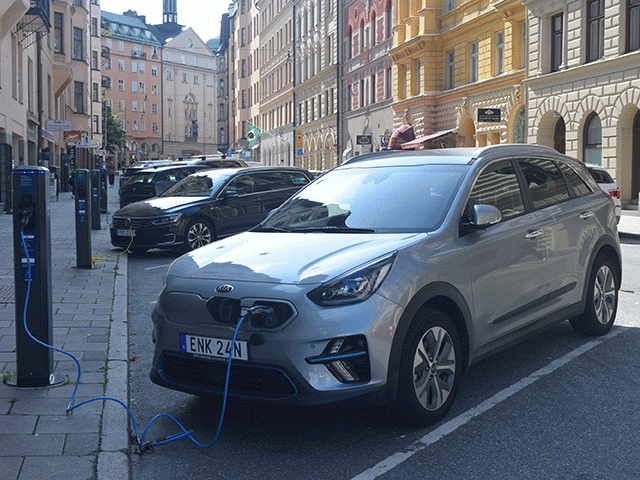CoBank: Rural EV Adoption to Expand
CoBank Predicts Electric Vehicle Expansion Will Accelerate in Rural Areas
LINCOLN, Neb. (DTN) -- Though many rural communities have been bolstered by the biofuels boom of the past 15 years, the door is opening for expanded adoption of electric-vehicle technology in rural America, a new report from CoBank suggests.
During its first six months in power, the Biden administration has stepped up federal efforts to address climate change, including a push to expand the availability and use of electric vehicles. Those efforts have created anxiety among biofuels producers and farmers who say ethanol and biomass biodiesel are already available and effective tools to combat climate change.
Biofuels interests continue to push for expanded investment in infrastructure to support higher ethanol and biodiesel volumes and federal policies to support continued industry growth.
But in a new report, "Co-op EVolution -- Bridging the Rural-Urban Divide on EV Adoption," CoBank said recent developments in the EV market are likely to accelerate adoption of the technology in rural areas.
"Given new commitments by car manufacturers, expanded policy incentives, and ambitious build-out of charging infrastructure, electric vehicles could make up 10% of all new car sales by 2025 -- a five-fold increase from current levels. With roughly 17 million new car and truck sales occurring each year, the 1.5 million to 2 million potential new EVs hitting the road will begin to make a difference as the U.S. vehicle inventory turns over," CoBank said.
"For rural communities, we see the possibility of real change taking hold, with 2% to 5% of all new car sales likely to be electric by mid-decade."
Only 1% of the estimated 250 million light-duty vehicles on the road are electric, the report said, but the possibility of accelerated adoption rates could mean 15% of the operating fleet will be electric by 2035.
CoBank is a $160 billion cooperative bank that provides loans, leases, export financing and other financial services to agribusinesses and rural power, water and communications providers in all 50 states.
P[L1] D[0x0] M[300x250] OOP[F] ADUNIT[] T[]
CoBank said that because rural residents drive more miles, a transition to EVs "represents a significant cost savings" during the life of the vehicle.
"With total ownership savings over the life of most EVs greater for rural communities, the reduced sticker price, and an expanded choice of mainstream car models, we think the adoption gap with urban cities will begin to narrow," CoBank said.
"With 80% or more of re-charging taking place at home, rural electric cooperatives will play an influential role preparing for membership adoption."
A recent study by M.J. Bradley and Associates found rural residents tend to spend more of their income on gasoline. Rural residents are also more likely than urban residents to live in single-family homes, improving their ability to charge their own vehicles. Electric vehicle sales have increased during the past decade from few in 2010 to 328,000 in 2020.
CoBank said the introduction of the Ford F-150 Lightning EV could change the tide in rural areas.
"The Ford F-Series is not only the top-selling model in more than 30 states, it has reigned as America's best-selling truck for 40 straight years and the bestselling vehicle for 35 years in a row," CoBank said.
"Thus far, the lack of diverse EV model options has limited the appeal of ownership for rural Americans -- especially as data shows drivers in rural areas are more likely to own medium- and heavy-duty pickup trucks. However, Ford's introduction of the F-150 Lightning will likely prove a game-changer for rural drivers who never before would have considered buying an EV."
According to the U.S. Department of Energy's Alternative Fuels Data Center, there are 42,440 public recharging stations across the country including about one-third concentrated in California.
The Biden administration has proposed spending at least $15 billion to increase the number of charging stations, with the goal of reaching 500,000 nationwide by 2030.
"Previous obstacles to rural adoption of EVs -- initial cost of ownership, model availability and limited range -- have diminished rapidly and are expected to continue doing so," CoBank said.
On average, CoBank said, most consumers can expect to save nearly $8,000 in fuel costs during the life of an electric vehicle.
"From a grid management perspective, the amount of electricity the U.S. consumes will certainly increase with greater EV adoption," said Teri Viswanath, lead energy economist with CoBank.
"However, the investment required to accommodate this growth may be smaller than it appears, as many regions already have sufficient generation capacity if vehicles are charged during off-peak hours."
Read the CoBank report here: https://www.cobank.com/….
Todd Neeley can be reached at todd.neeley@dtn.com
Follow him on Twitter @DTNeeley
(c) Copyright 2021 DTN, LLC. All rights reserved.






